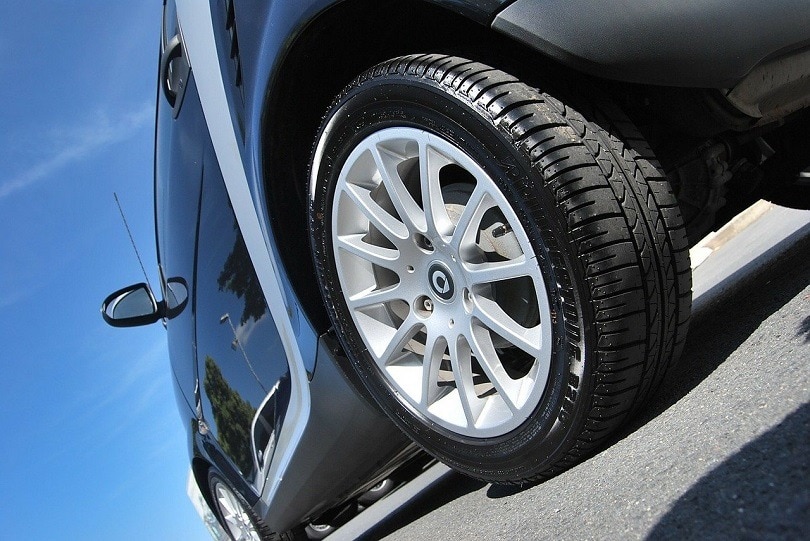18 vs 20-inch Wheels: What’s the Difference?
-

- Last updated:

Many car owners consider larger wheels to be more visually appealing. They tend to have lower sidewalls, which means there is more of the wheel on display. However, looks aren’t everything. Changing wheel size can have an impact on acceleration, fuel economy, and handling. So, are 18-inch wheels or 20-inch wheels better, and are there any noticeable differences once you’re driving? What do you need to consider when choosing the best wheel size for your vehicle?

Wheel Size and Its Impact on Tire Construction
When considering a larger wheel, it is important to look at the size of the whole wheel and tire construction. Generally, larger wheels are lower profile, which means that they are thinner and have less of a sidewall. In fact, if you’re replacing the wheels yourself and increasing or decreasing their size, it is important to look at the overall dimensions.
If you increase the diameter of the wheel without reducing the thickness of the tire, it means that your speedometer will be inaccurate, and it can make as much as a 7% or 8% difference to the speed displayed on your clock and the actual speed you’re traveling. By reducing the thickness of the tire, it means that the difference should be negligible or non-existent. Also, if you have the wheels replaced professionally, you should be able to get this discrepancy fixed so your speedometer remains accurate.

Larger Wheels Are Heavier
Generally, 20-inch wheels are heavier than 18-inch wheels, unless you invest in lightweight alternatives. A 20-inch model will likely be 2–3 pounds heavier than an 18-inch wheel. Lighter wheels offer better performance and improved acceleration compared to heavier ones, so 18-inch wheels offer improved performance. The difference isn’t likely to be huge unless you are on a racetrack, when shaving fractions of a second off your lap time matters. Changing from steel wheels to alloy wheels has a greater impact on the weight of the wheels.
20-Inch Wheels Cost More
It takes more metal to make 20-inch wheels, and this additional cost is passed on to the consumer. However, while there used to be a noticeable difference in price between these and 18-inch models, the difference is much smaller today because demand for 20-inch wheels has increased. It is worth comparing the cost when you are deciding, though.
20-Inch Wheels Could Improve Traction
20-inch wheels have a larger tire surface, and more of the tire will come into contact with the road. In poor driving conditions, such as on icy roads or driving on mud, the extra contact can increase grip. If you live in an area that is prone to oily, damp, or icy road conditions, 20-inch wheels could give you a safer ride that is easier to control, although winter tires will yield greater benefits and improved control.
18-Inch Tires Offer Improved Ride Comfort
Larger wheels tend to have lower-profile tires, achieved by using a smaller sidewall. This means that there is less air in the tire, providing less of a cushion against the road. When you drive over bumps, the air cushion in smaller diameter tires helps dampen the feeling of the road, therefore improving the ride quality. The additional cushion from the 18-inch wheels also reduces road noise in the cabin, potentially improving the overall driving experience.
Better Acceleration with Smaller Wheels
The additional weight and size of the 20-inch wheels mean that the car’s engine has to work harder to turn those wheels. For the driver, this means that the smaller wheels actually make it easier for the car to accelerate. While fitting larger wheels under the arches can improve the look of a car, they diminish its acceleration, although you are unlikely to notice the difference unless you swap from one set of tires to another. Even then, the difference is minimal, and the average driver is unlikely to recognize the difference.
Looks
The primary decision of 18-inch vs. 20-inch wheels comes down to personal preference. Many people choose larger models because of their visual appeal. Small wheels can look lost under wheel arches, and by upsizing even by 1–2 inches, it is possible to safely fill the chasm between the chassis and wheel. This gives a more aggressive look, and if you have ever been to a meet or rally, you will notice that many car modders prefer this look.
18 vs 20 Inch Wheels: Which is Best?
Although larger wheels tend to look better, smaller wheels have several advantages. They offer better acceleration, are lighter, and improve the ride quality. If you’re buying based solely on aesthetics, opt for the 20-inch rims and ensure that your speedometer still matches the actual speed. If comfort or performance are the most important attributes to you, 18-inch wheels will be better suited.
Featured Image Credit: PublicDomainPictures, Pixabay
Contents

